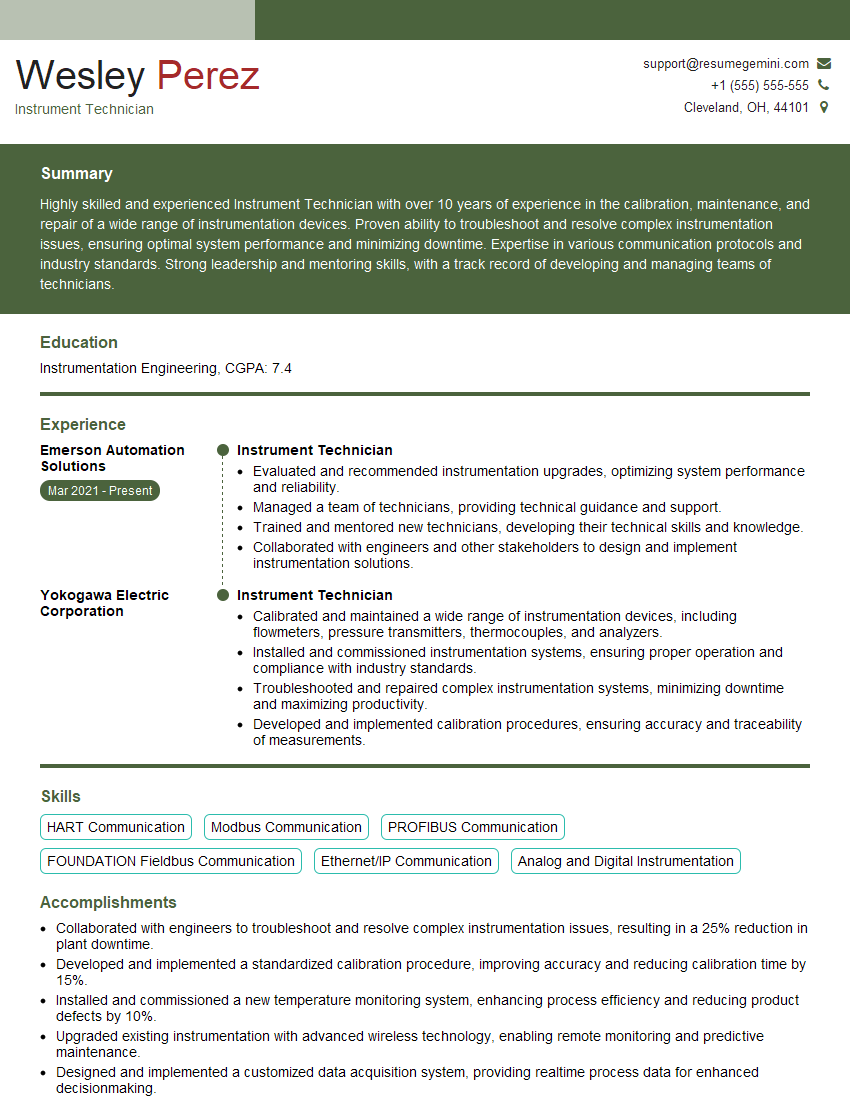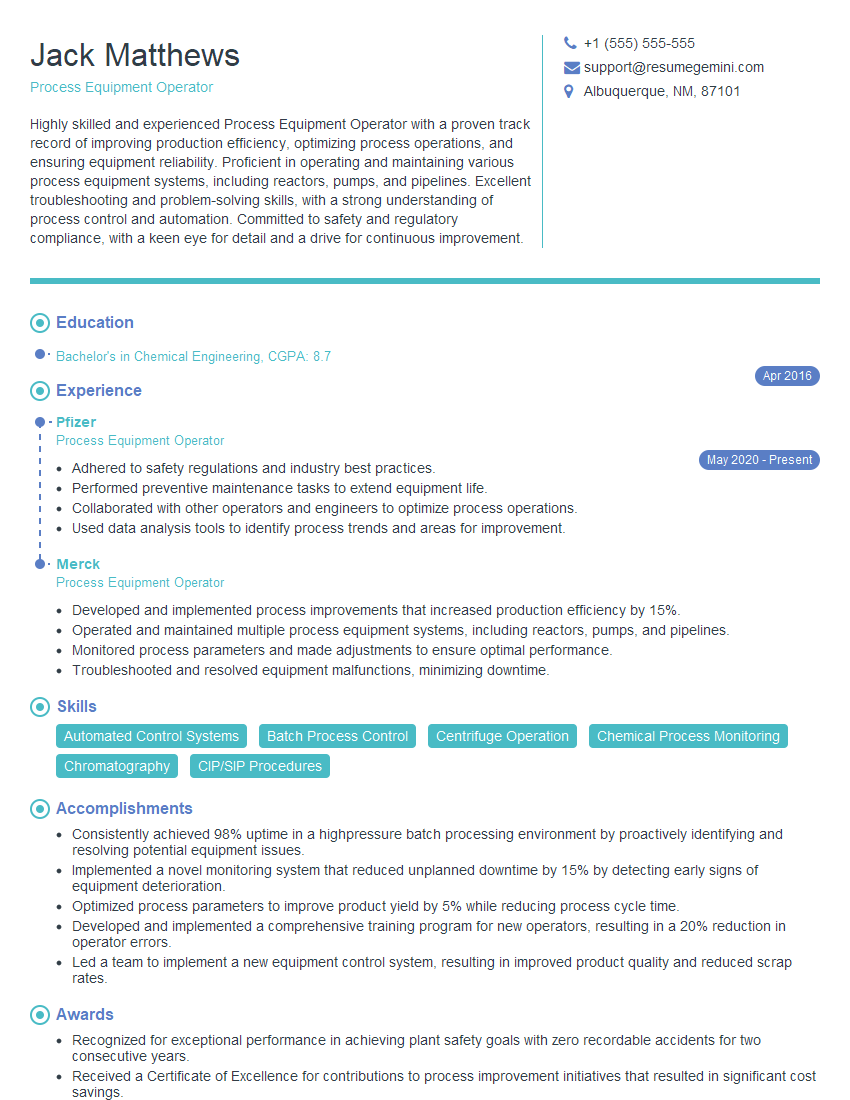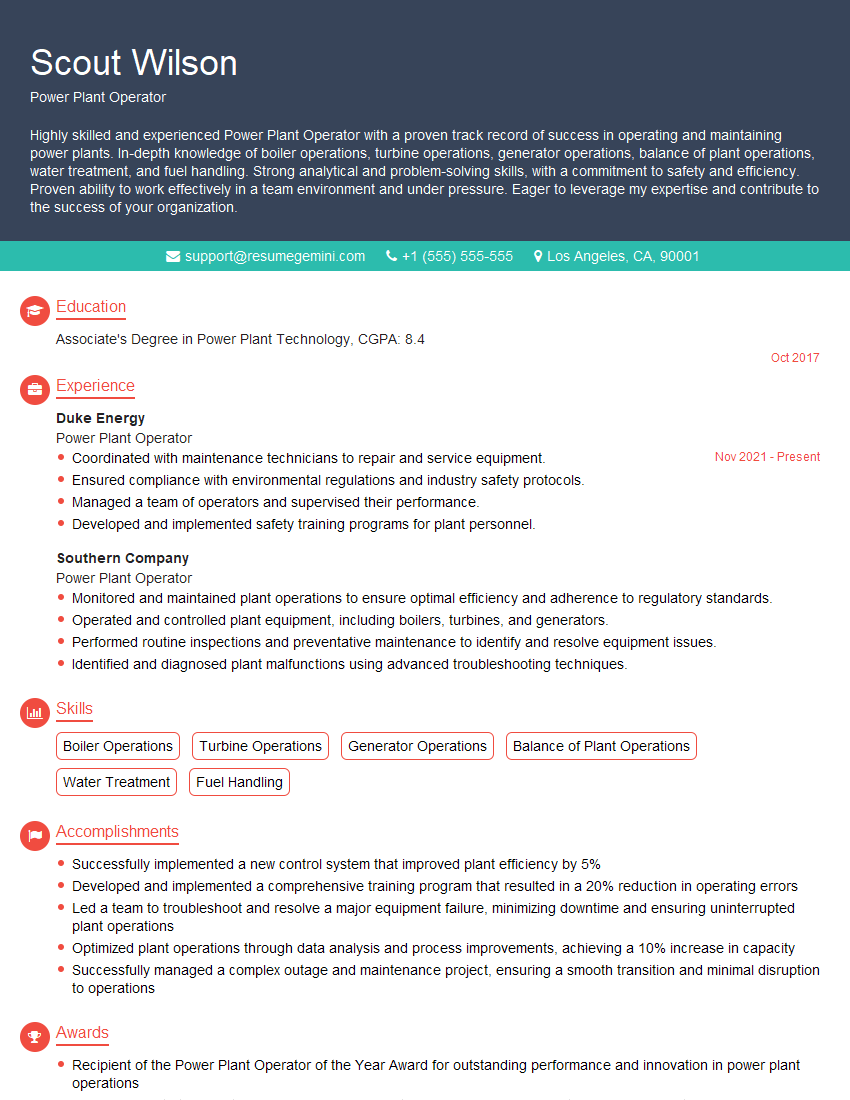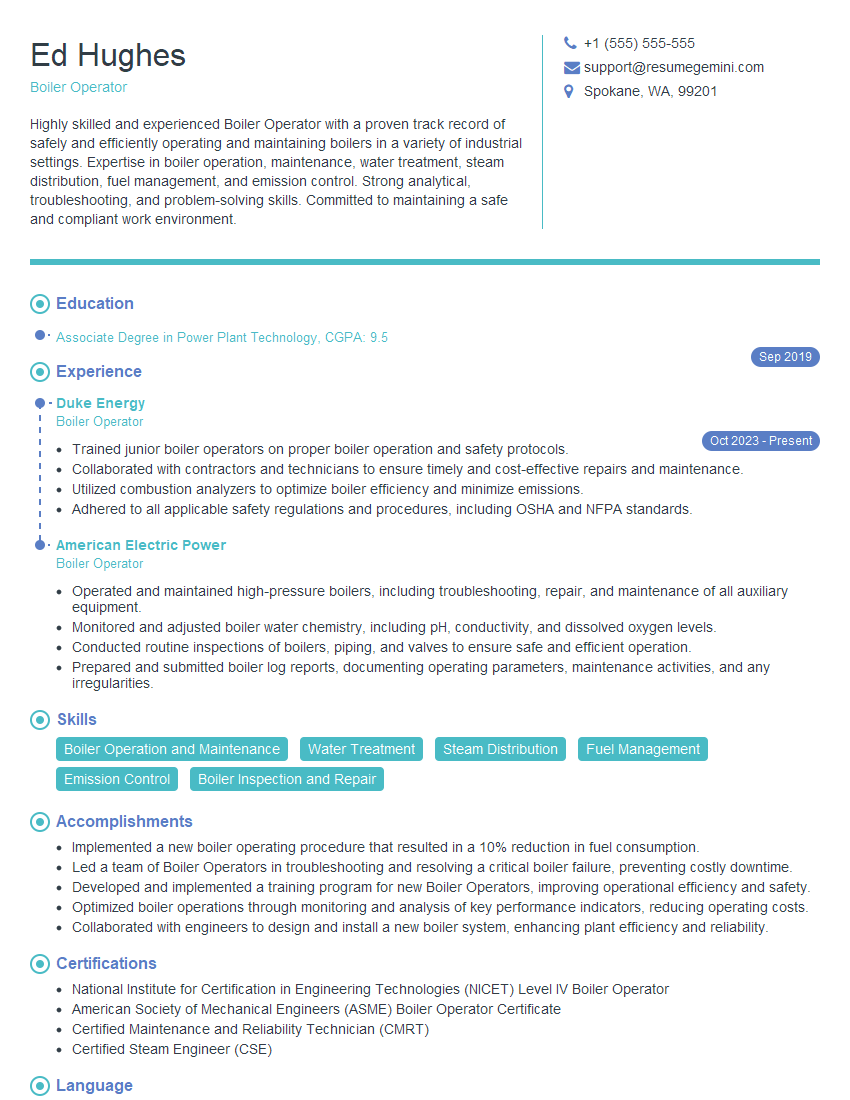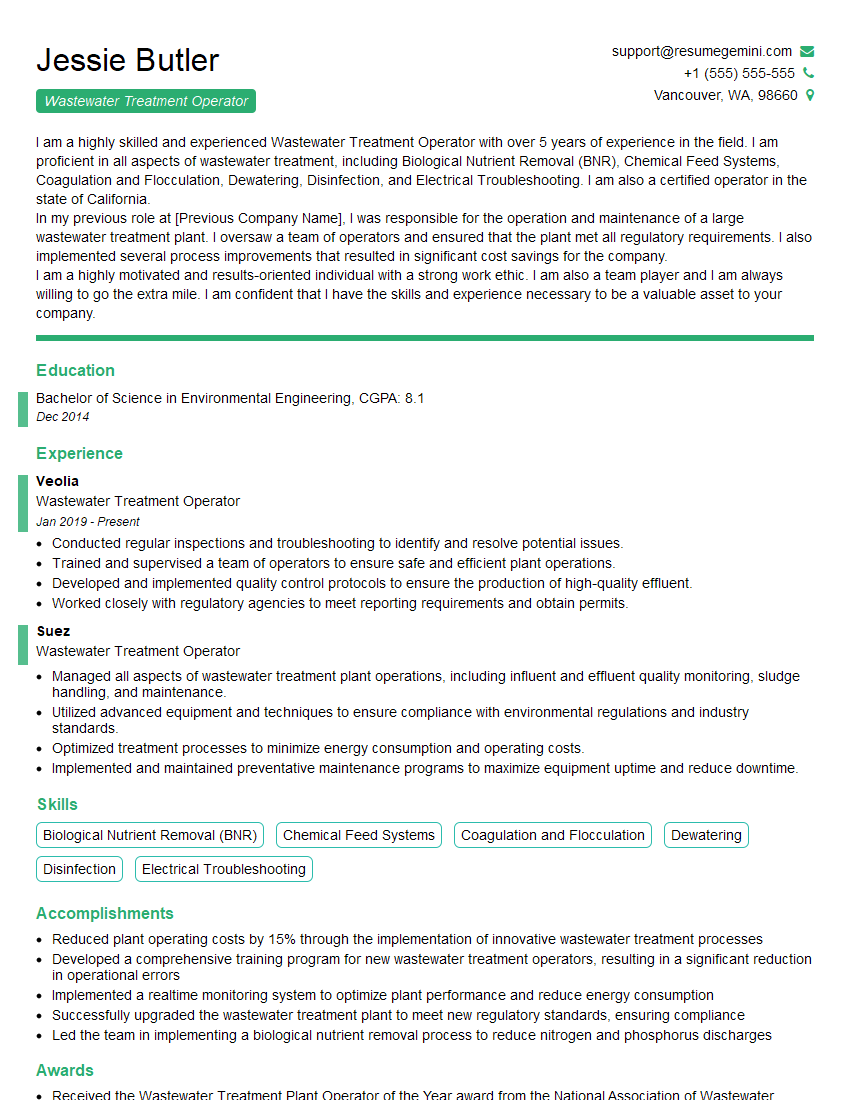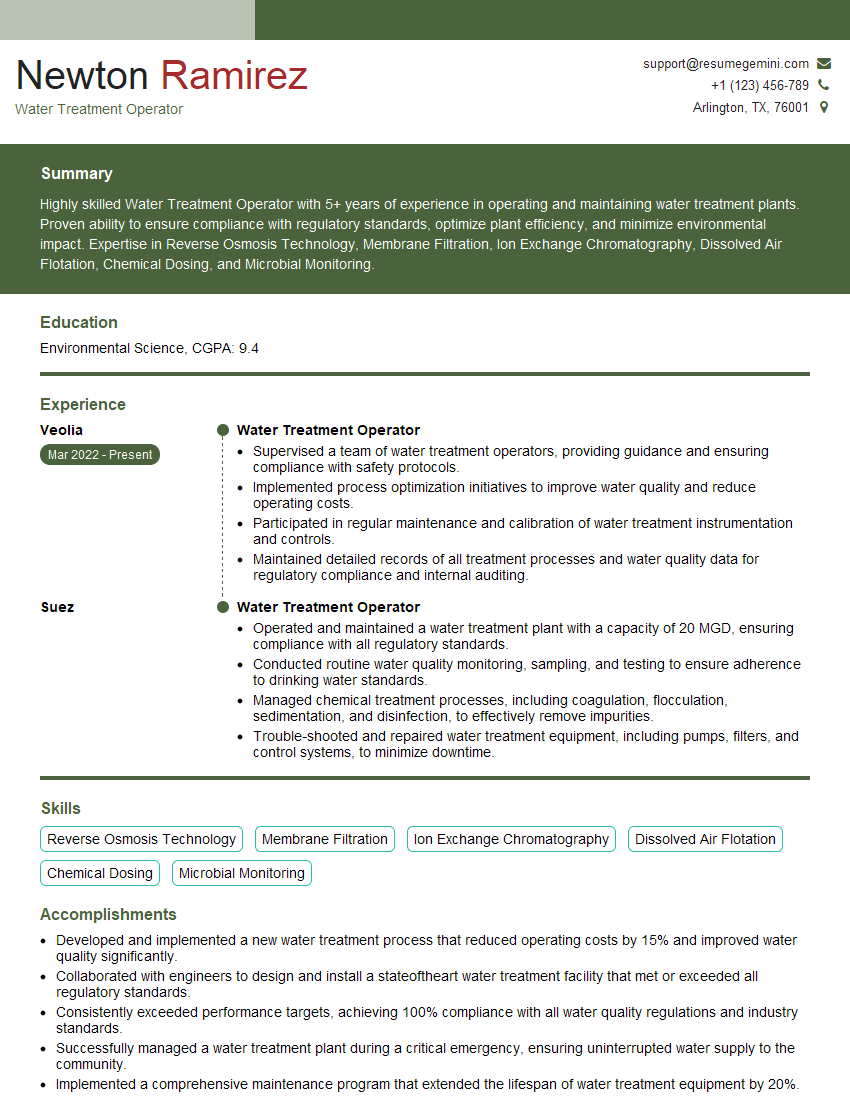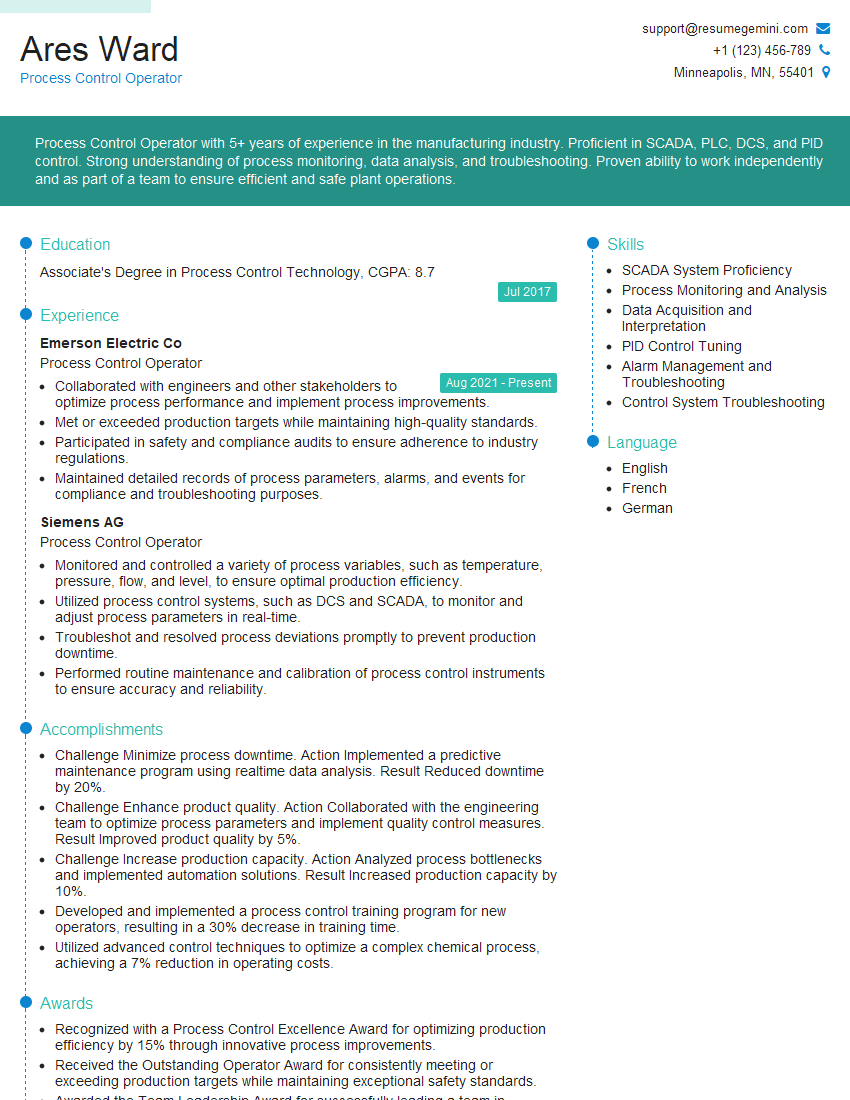Interviews are more than just a Q&A session—they’re a chance to prove your worth. This blog dives into essential Ancillary Equipment Operation interview questions and expert tips to help you align your answers with what hiring managers are looking for. Start preparing to shine!
Questions Asked in Ancillary Equipment Operation Interview
Q 1. Describe your experience with troubleshooting common ancillary equipment malfunctions.
Troubleshooting ancillary equipment malfunctions requires a systematic approach. I begin by identifying the specific problem – is it a complete shutdown, reduced output, unusual noise, or a safety alarm? Then, I use a combination of diagnostic tools, knowledge of the equipment’s operational principles, and my experience to pinpoint the root cause. For example, if a boiler isn’t producing enough steam, I might check fuel supply, water levels, burner operation, and the condition of the heat exchanger. If a pump fails to start, I would investigate power supply, motor condition, and potential blockages. I document all troubleshooting steps, repairs, and their outcomes to improve future response times and prevent recurring issues.
I’ve encountered several scenarios where seemingly simple problems – a loose wire, a clogged filter, or a faulty sensor – masked more complex issues. In one instance, a chiller’s low cooling capacity was initially attributed to refrigerant leakage. However, thorough investigation revealed a failing compressor motor causing the reduced efficiency, before leakage became a factor. This emphasizes the importance of detailed investigation and not jumping to conclusions.
Q 2. Explain the safety procedures you follow when operating ancillary equipment.
Safety is paramount when operating ancillary equipment. My safety procedures always start with a thorough pre-operational inspection – checking for leaks, loose connections, and ensuring all safety guards are in place. I always wear appropriate Personal Protective Equipment (PPE), including safety glasses, gloves, and hearing protection, as needed. Lockout/Tagout (LOTO) procedures are strictly followed before any maintenance or repair work is undertaken, ensuring the equipment is completely isolated from power sources. I’m familiar with emergency shutdown procedures for every piece of equipment I operate and know the location of fire extinguishers and other safety equipment. Regular safety training keeps me up-to-date with the latest best practices and potential hazards.
Think of it like this: just as a pilot runs pre-flight checks, I conduct thorough pre-operational checks to mitigate risk. This proactive approach is fundamental to preventing accidents and ensuring a safe working environment.
Q 3. What are the key performance indicators (KPIs) you monitor for ancillary equipment?
Key Performance Indicators (KPIs) for ancillary equipment vary depending on the specific type of equipment, but generally include operational efficiency, uptime, energy consumption, and maintenance costs. For a boiler, KPIs might include steam production rate, fuel efficiency (BTU/lb of steam), and water treatment chemical usage. For a chiller, KPIs might include cooling capacity, power consumption (kW/ton), and refrigerant pressure. I monitor these KPIs using a combination of automated systems (SCADA, PLC data) and manual checks, regularly analyzing trends to identify potential problems before they escalate. Unexpected changes in these parameters are early warning signs that often allow for preventive action.
For instance, consistently higher-than-normal energy consumption for a chiller could indicate a problem with the compressor or condenser, which I can investigate before a major failure occurs.
Q 4. How do you perform preventative maintenance on ancillary equipment?
Preventative maintenance is crucial for extending the lifespan of ancillary equipment and minimizing downtime. My approach is based on the manufacturer’s recommendations and incorporates both scheduled and condition-based maintenance. Scheduled maintenance involves regular inspections, cleaning, lubrication, and component replacements based on predetermined intervals (e.g., oil changes for pumps, filter replacements for air compressors). Condition-based maintenance uses monitoring data and diagnostic tools to assess the condition of the equipment and schedule maintenance only when necessary (e.g., vibration analysis for pumps, thermal imaging for electrical panels). Detailed records are kept to track maintenance activities and identify recurring issues.
A good analogy is regular car maintenance; changing oil, rotating tires, and checking fluids prevents major breakdowns down the road. Preventative maintenance on ancillary equipment follows the same logic.
Q 5. What are the different types of ancillary equipment you are familiar with?
I’m familiar with a wide range of ancillary equipment, including:
- Boilers (fire-tube, water-tube)
- Chillers (absorption, centrifugal, reciprocating)
- Cooling towers
- Pumps (centrifugal, positive displacement)
- Air compressors
- HVAC systems
- Emergency generators
- Water treatment systems
My experience spans diverse industries, giving me a broad perspective on different applications and challenges related to these systems.
Q 6. Explain the process of starting and shutting down a specific type of ancillary equipment (e.g., boiler).
Let’s take a boiler as an example. Starting a boiler involves several steps:
- Pre-start checks: Inspect water levels, fuel supply, and safety devices. Ensure all necessary permits and LOTO procedures are in place.
- Fill the boiler: Add water to the correct level, checking for leaks.
- Purge the air: Remove air from the system to prevent damage.
- Light the burner: Follow the specific sequence and safety precautions outlined in the manufacturer’s manual. This often involves checking flame sensors and ensuring proper fuel-air mixture.
- Monitor parameters: Continuously monitor water pressure, temperature, and fuel consumption to ensure safe and efficient operation.
- Bring to operating pressure: Gradually increase the pressure to the desired level, closely monitoring all parameters.
Shutting down a boiler requires the reverse process, gradually reducing fuel input, monitoring pressure and temperature to prevent thermal shock, and allowing the system to cool down safely before any maintenance is performed. Detailed procedures are always followed to ensure safety and minimize the risk of damage.
Q 7. How do you identify and address potential hazards associated with ancillary equipment operation?
Identifying and addressing potential hazards is a continuous process. I utilize a combination of risk assessments, safety audits, and regular inspections to proactively identify potential hazards. This includes evaluating the physical condition of the equipment, the environment it operates in, and the potential for human error. For example, I check for potential leaks, electrical hazards, and moving parts that could cause injury. I also consider the risk of fire or explosions, especially when dealing with fuel systems.
In one incident, we noticed a buildup of sediment in a cooling tower. Left unaddressed, this could have reduced efficiency, even leading to equipment failure. By identifying and cleaning the sediment, we prevented a potential hazard and maintained optimal operation. Addressing potential hazards proactively ensures a safer work environment and prevents costly downtime.
Q 8. Describe your experience with data logging and reporting related to ancillary equipment performance.
Data logging and reporting are crucial for optimizing ancillary equipment performance and ensuring regulatory compliance. My experience involves utilizing various software and hardware systems to collect real-time data on parameters such as pressure, temperature, flow rate, and vibration from different types of equipment. This data is then analyzed to identify trends, predict potential failures, and optimize operational efficiency.
For example, in a recent project involving a large water treatment plant, I implemented a SCADA (Supervisory Control and Data Acquisition) system to monitor the performance of pumps, filters, and chemical dosing systems. The system automatically logged data every minute, which was then used to generate daily, weekly, and monthly reports. These reports allowed us to identify a recurring issue with a specific pump, leading to proactive maintenance and preventing a costly shutdown.
I’m proficient in using data analysis tools like Excel and specialized software to create comprehensive reports that visualize key performance indicators (KPIs) and highlight areas for improvement. This includes generating charts, graphs, and statistical analyses to present findings effectively to both technical and non-technical stakeholders.
Q 9. What is your experience with different types of control systems used in ancillary equipment?
My experience encompasses a wide range of control systems used in ancillary equipment, from simple on/off controls to sophisticated PLC-based systems. I’m familiar with pneumatic, hydraulic, and electronic control systems, and I understand the strengths and limitations of each. I’ve worked with various PLC platforms, including Allen-Bradley, Siemens, and Schneider Electric, and I’m comfortable programming and troubleshooting these systems.
For instance, I’ve worked on projects where we migrated from older pneumatic control systems to modern PLC-based systems to improve efficiency and reliability. This involved designing the new control logic, programming the PLCs, and integrating them with existing instrumentation. The transition resulted in improved control precision, reduced maintenance, and better data acquisition capabilities. Additionally, I have experience with Distributed Control Systems (DCS) frequently found in larger industrial settings.
My understanding extends to different communication protocols used in these systems, such as Modbus, Profibus, and Ethernet/IP, allowing me to seamlessly integrate different components and optimize data exchange.
Q 10. How do you handle emergency situations involving ancillary equipment malfunctions?
Handling emergency situations requires a calm and systematic approach. My first priority is always safety. I follow a structured emergency response protocol that prioritizes isolating the malfunctioning equipment, assessing the situation, and taking appropriate actions to mitigate any risks.
This includes activating emergency shutdown procedures, contacting relevant personnel, and initiating repairs or replacements as necessary. For instance, if a pump fails and causes a pressure drop in a critical system, I’d immediately isolate the faulty pump, switch to a backup system (if available), and then begin troubleshooting the primary pump to identify the root cause. Detailed documentation of the event, including the cause, corrective actions, and preventative measures, are crucial for future analysis and improvement.
Thorough documentation and post-incident analysis are essential for preventing similar incidents in the future. This involves investigating the root cause and implementing corrective actions to prevent recurrence.
Q 11. What is your understanding of regulatory compliance related to ancillary equipment operation?
Regulatory compliance is paramount in ancillary equipment operation. My understanding encompasses various regulations, including OSHA (Occupational Safety and Health Administration), EPA (Environmental Protection Agency), and industry-specific codes. I’m knowledgeable about safety standards, emission control requirements, and waste disposal protocols applicable to the types of equipment I operate and maintain.
For example, I understand the requirements for lockout/tagout procedures to prevent accidental start-ups during maintenance, and I ensure all equipment is regularly inspected and maintained to meet safety standards. I am also aware of the necessity of maintaining accurate records of inspections, maintenance activities, and any environmental releases. Staying updated on regulatory changes and ensuring compliance are an ongoing process that requires continuous learning and proactive measures. This often involves attending industry workshops and actively reviewing updated regulations.
Q 12. How do you ensure the efficient and effective operation of ancillary equipment?
Ensuring efficient and effective ancillary equipment operation requires a multifaceted approach combining preventative maintenance, optimized settings, and data-driven decision-making. This involves developing and implementing a comprehensive maintenance plan that includes regular inspections, lubrication, and component replacements based on manufacturers’ recommendations and historical performance data.
Optimizing equipment settings, such as flow rates, pressures, and temperatures, based on real-time data and process requirements is also critical. This can often involve using advanced control strategies, such as PID (Proportional-Integral-Derivative) control, to maintain optimal operating conditions. Regular performance monitoring, coupled with data analysis, helps to identify areas for improvement and implement proactive measures to avoid potential issues.
For example, by carefully analyzing historical data on energy consumption, I was able to identify an opportunity to optimize the settings of a compressor, resulting in a significant reduction in energy consumption without compromising system performance. This involved making minor adjustments to the control parameters and improving the system’s efficiency.
Q 13. Describe your experience working with different types of pumps and compressors.
I have extensive experience working with various types of pumps and compressors, including centrifugal pumps, positive displacement pumps, reciprocating compressors, and centrifugal compressors. I understand the operating principles, applications, and maintenance requirements of each type. This understanding extends to troubleshooting common issues, such as cavitation in pumps and surging in compressors.
For instance, I’ve successfully diagnosed and resolved issues related to pump cavitation by adjusting suction pressure and implementing modifications to the piping system. I’m also familiar with different pump and compressor drive systems, including variable frequency drives (VFDs), which allow for precise speed control and energy savings. In my experience, choosing the correct pump or compressor for a specific application is critical for optimizing performance, and I consider factors such as flow rate, pressure, viscosity, and fluid characteristics when making these selections.
Q 14. How familiar are you with Programmable Logic Controllers (PLCs) used in ancillary equipment?
I’m very familiar with Programmable Logic Controllers (PLCs) used in ancillary equipment. I’m proficient in programming PLCs using ladder logic and other programming languages, and I’m comfortable troubleshooting and maintaining PLC-based control systems. My experience encompasses various PLC brands and platforms, and I understand how PLCs are used to control and monitor a wide range of equipment.
Example Ladder Logic Code (Illustrative):--|---|---[XIC Pump_Start]---(OTE Pump_Motor)--This snippet shows a simple ladder logic program that turns on a pump motor when a start signal is received.
Furthermore, I’m comfortable working with HMI (Human-Machine Interface) software to create user-friendly interfaces for operators to monitor and control the equipment. This is important for ensuring safe and efficient operation.
Q 15. What is your experience with hydraulic and pneumatic systems used in ancillary equipment?
My experience with hydraulic and pneumatic systems in ancillary equipment is extensive. I’ve worked with systems ranging from small, localized actuators controlling valve positions to large-scale hydraulic power units driving heavy machinery. Understanding these systems involves a thorough grasp of fluid mechanics, including pressure, flow rate, and component behavior.
For instance, I’ve successfully troubleshooted a leaking hydraulic cylinder on a large industrial press by meticulously tracing the fluid lines, isolating the leak point, and replacing the faulty seal. In pneumatic systems, I’ve worked extensively with air compressors, air dryers, and various pneumatic valves, ensuring consistent and reliable operation of equipment like robotic arms and automated clamping systems. This includes understanding air pressure regulation, filtration, and the nuances of different types of pneumatic actuators like cylinders and grippers. My proficiency includes preventative maintenance, predictive maintenance using vibration analysis, and the ability to diagnose and repair leaks, component failures, and performance issues in both systems.
Career Expert Tips:
- Ace those interviews! Prepare effectively by reviewing the Top 50 Most Common Interview Questions on ResumeGemini.
- Navigate your job search with confidence! Explore a wide range of Career Tips on ResumeGemini. Learn about common challenges and recommendations to overcome them.
- Craft the perfect resume! Master the Art of Resume Writing with ResumeGemini’s guide. Showcase your unique qualifications and achievements effectively.
- Don’t miss out on holiday savings! Build your dream resume with ResumeGemini’s ATS optimized templates.
Q 16. Explain your understanding of energy efficiency measures related to ancillary equipment.
Energy efficiency in ancillary equipment is critical for both cost savings and environmental responsibility. My approach involves multiple strategies. First, I prioritize preventative maintenance to ensure components are running at peak efficiency and to avoid energy-wasting inefficiencies caused by friction, leaks, or inefficient operations. Second, I advocate for the implementation of variable speed drives (VSDs) for motors driving pumps and compressors. VSDs allow the speed to match the demand, reducing energy consumption significantly. Third, I always evaluate the need for equipment itself. Sometimes streamlining processes and eliminating unnecessary equipment can drastically reduce energy consumption. Finally, I evaluate the use of more efficient components – for example, utilizing high-efficiency motors and pumps. For example, in one project, by implementing VSDs on a series of pumps, we achieved a 25% reduction in energy consumption without compromising performance.
Q 17. Describe your experience with troubleshooting electrical issues in ancillary equipment.
Troubleshooting electrical issues requires a systematic approach combining practical experience with a strong understanding of electrical theory. My expertise includes using multimeters to measure voltage, current, and resistance; interpreting wiring diagrams; and identifying faulty components like motors, sensors, and control relays. I’m proficient in working safely with high voltage systems, following all lockout/tagout procedures. For example, recently, I isolated a faulty motor in a conveyor system by using a multimeter to trace the circuit, identifying a short in the motor windings, and ultimately replacing the faulty motor. My experience also includes working with Programmable Logic Controllers (PLCs), understanding their programming, and diagnosing issues within their logic.
Q 18. How do you maintain accurate records and documentation related to ancillary equipment operations?
Accurate record-keeping is crucial for efficient maintenance and compliance. I utilize a combination of Computerized Maintenance Management Systems (CMMS) and physical logbooks. CMMS software allows for tracking of maintenance activities, parts usage, and scheduled maintenance, ensuring everything is documented digitally and easily searchable. Physical logbooks provide a backup for essential data and detailed information that might not be suitable for the CMMS. This two-pronged approach allows for easy tracking of equipment history, identifying trends, and supporting future maintenance decisions. For example, detailed records of oil changes and lubrication schedules on critical equipment prevent premature failures and prolong operational lifespan.
Q 19. What is your understanding of the different types of valves used in ancillary equipment?
Ancillary equipment utilizes a wide range of valves, each designed for specific applications. Common types include:
- Ball valves: Simple on/off control with a rotating ball.
- Globe valves: Precise flow control using a plug to restrict flow.
- Gate valves: Primarily for on/off applications, offering little flow control once open.
- Butterfly valves: Rapid on/off and flow regulation with a rotating disc.
- Check valves: Prevent backflow in a pipeline.
- Pressure relief valves: Protect systems from overpressure.
- Proportional valves: Provide precise and variable flow control in response to a signal.
My experience encompasses selecting, installing, and maintaining these valves in various applications, understanding their limitations and the specific requirements of each type.
Q 20. Explain your experience with using diagnostic tools and software for ancillary equipment.
I’m proficient in utilizing a range of diagnostic tools and software. This includes using multimeters, oscilloscopes, and specialized equipment like infrared thermometers to detect overheating components. Furthermore, I have experience with CMMS software for tracking maintenance, PLC programming software for diagnosing control system issues, and specialized diagnostic software provided by equipment manufacturers. For example, I’ve used manufacturer-specific software to diagnose a fault code on a complex hydraulic pump, leading to a timely repair and preventing significant downtime.
Q 21. Describe a time you had to troubleshoot a complex ancillary equipment problem. What was your approach?
I once faced a complex issue with a malfunctioning automated palletizer. The system wouldn’t complete its cycle, resulting in production delays. My approach was systematic:
- Gather information: I started by carefully observing the system’s behavior and collecting information from operators about when the problem began and any preceding events.
- Check the obvious: I first inspected all the simple things – power, air pressure, and basic sensor readings. These checks revealed normal readings.
- Utilize diagnostic tools: I then used the palletizer’s PLC diagnostic software to identify specific fault codes. This narrowed down the problem to a potential issue within the PLC’s logic.
- Trace the logic: I reviewed the PLC program step by step, simulating the palletizer’s movements to pinpoint the exact point of failure. This highlighted a logic error in the sequence of actions.
- Implement the solution: I corrected the logic error in the PLC program, uploaded the updated code, and retested the system. The palletizer functioned correctly, resolving the issue.
This systematic approach, combining observation, diagnostic tools, and a thorough understanding of the system’s logic, allowed me to quickly and efficiently resolve the problem.
Q 22. What are the common causes of failure for [specific ancillary equipment type]?
Let’s say we’re discussing the common causes of failure for high-pressure boiler feed pumps. These are crucial in power generation and industrial processes. Failures can stem from several sources, broadly categorized as mechanical, electrical, and operational issues.
Mechanical Failures: These often involve wear and tear on moving parts. For instance, bearing failures due to insufficient lubrication or overloading can cause catastrophic pump damage. Cavitation, where vapor bubbles collapse within the pump, can erode impeller blades over time. Seal failures, leading to leaks, are also prevalent and often require immediate attention. Think of it like a car engine – if a vital bearing goes, the entire system suffers.
Electrical Failures: Problems with the motor driving the pump are a significant concern. This includes issues with the motor windings, overheating due to prolonged operation or inadequate cooling, and failures in the motor control system. Imagine a sudden power surge frying the motor’s delicate internal circuitry – that’s a costly downtime scenario.
Operational Failures: These are often preventable. Operating the pump outside its design parameters, such as running it dry or exceeding the maximum pressure, can cause significant damage. Inadequate suction pressure can lead to cavitation. Regular inspection and adherence to operating procedures are key here. Think of it like driving a car too fast or ignoring warning lights.
Addressing these failures involves predictive maintenance strategies like vibration analysis, oil analysis, and regular inspections to detect wear and potential problems before they lead to complete system failure. This prevents costly downtime and ensures operational safety.
Q 23. How do you prioritize maintenance tasks for different pieces of ancillary equipment?
Prioritizing maintenance is crucial for maximizing uptime and minimizing costly breakdowns. I use a risk-based approach, considering factors like criticality, reliability, and the potential impact of failure. A critical piece of equipment, like a main air compressor for a manufacturing plant, gets prioritized over a less critical item, say a smaller auxiliary pump. My framework involves:
Criticality Analysis: Ranking equipment based on its importance to overall operations. A system failure would bring the entire production line to a halt needs immediate attention compared to something with minimal impact.
Reliability Data: Using historical data on equipment failures and maintenance intervals to predict when maintenance is needed. This is about leveraging past experiences to anticipate future needs.
Risk Assessment: Evaluating the probability and consequence of failure for each piece of equipment. Equipment prone to catastrophic failure gets higher priority.
Cost-Benefit Analysis: Balancing the cost of maintenance with the potential cost of failure. Proactive maintenance may be more expensive upfront, but it avoids costly emergency repairs.
I also use computerized maintenance management systems (CMMS) to track maintenance schedules, spare parts inventory, and equipment history, streamlining the process and making it much more efficient. This allows us to visualize the maintenance workload, predict failures and allocate resources accordingly.
Q 24. Describe your experience with working in a team environment to maintain ancillary equipment.
Teamwork is essential in ancillary equipment operation. In my previous role, we had a team of five, including electricians, mechanics, and operators. We utilized a collaborative approach, sharing expertise and responsibilities. For example, during a major boiler outage, the electricians handled the electrical components, the mechanics addressed the mechanical issues, and the operators monitored the progress and provided feedback based on their practical experience. This ensured efficiency and reduced the likelihood of errors. We held regular team meetings to discuss challenges, share best practices, and plan upcoming maintenance activities.
Effective communication was paramount. We employed clear, concise reporting mechanisms to ensure everyone was informed about ongoing tasks and potential issues. Clear roles and responsibilities were defined to avoid confusion and duplication. For example, one member of the team was responsible for the detailed records, ensuring that all equipment maintenance was well documented in compliance with safety guidelines and industry standards.
Q 25. What are your strengths and weaknesses related to ancillary equipment operation?
My strengths lie in my deep understanding of various ancillary equipment types, my proficiency in troubleshooting complex issues, and my commitment to safety and preventative maintenance. I’m adept at diagnosing problems, quickly identifying root causes, and implementing effective solutions. For example, I once resolved a recurring issue with a cooling tower pump by analyzing vibration data and identifying a misalignment in the pump shaft, preventing further damage and downtime.
One area I’m actively working on is expanding my knowledge of advanced diagnostic technologies like infrared thermography and predictive analytics. While I’m comfortable with standard maintenance procedures, continually upgrading my skills in this rapidly evolving field is a key priority for my professional development.
Q 26. What are your salary expectations for this role?
My salary expectations are in line with the industry standard for an experienced Ancillary Equipment Operator with my qualifications and experience in this specific location. I’m open to discussing this further once I have a better understanding of the full scope of responsibilities and benefits package offered.
Q 27. What are your career goals related to ancillary equipment operation?
My career goals revolve around becoming a leader in the field of ancillary equipment operation. I aspire to leverage my expertise to improve operational efficiency and safety standards. I envision myself taking on more responsibility, possibly in a supervisory or management role, where I can mentor and train others. Ultimately, I aim to contribute to a company’s success by ensuring the smooth and reliable operation of its critical ancillary systems.
Q 28. Why are you interested in this specific Ancillary Equipment Operator position?
I’m particularly interested in this position because of [Company Name]’s reputation for innovation and commitment to safety. The opportunity to work with state-of-the-art equipment, contribute to a dynamic team, and apply my expertise to a challenging and rewarding role is very appealing. The company’s focus on [mention specific company value or project that interests you] aligns perfectly with my professional goals and values.
Key Topics to Learn for Ancillary Equipment Operation Interview
- Safety Procedures and Regulations: Understanding and adhering to all relevant safety protocols, including lockout/tagout procedures, personal protective equipment (PPE) usage, and emergency response plans. Practical application includes describing your experience with specific safety protocols and how you ensured a safe working environment.
- Equipment Maintenance and Troubleshooting: Knowledge of preventative maintenance schedules, recognizing signs of malfunction, and performing basic troubleshooting. This includes understanding the functionality of various components and how to address common issues. Practical application includes detailing your experience with equipment maintenance, troubleshooting specific problems, and preventative maintenance procedures.
- Operational Efficiency and Optimization: Strategies for maximizing equipment uptime and minimizing downtime through efficient operation and preventative maintenance. This also involves understanding production goals and how your role contributes to overall efficiency. Practical application includes describing scenarios where you improved efficiency or reduced downtime.
- Hydraulic and Pneumatic Systems: Understanding the principles of hydraulic and pneumatic systems, common components, and troubleshooting techniques related to these systems within Ancillary Equipment. This includes the ability to diagnose and resolve pressure, flow, and leakage issues. Practical application includes demonstrating your knowledge of hydraulic/pneumatic schematics and troubleshooting procedures.
- Data Acquisition and Analysis: Understanding how data from ancillary equipment is collected, interpreted, and used to monitor performance and identify areas for improvement. This might involve familiarity with specific data acquisition systems or software. Practical application includes examples of how you’ve used data to improve equipment performance or identify potential problems.
- Teamwork and Communication: Effective collaboration with other team members, reporting issues promptly and clearly, and actively participating in problem-solving. Practical application includes providing examples of successful teamwork experiences in previous roles.
Next Steps
Mastering Ancillary Equipment Operation is crucial for career advancement within the industry. It demonstrates your technical skills, commitment to safety, and ability to contribute to a productive work environment. To significantly improve your job prospects, creating an ATS-friendly resume is vital. ResumeGemini is a trusted resource that can help you build a professional and impactful resume tailored to highlight your skills and experience. Examples of resumes tailored to Ancillary Equipment Operation are available to help you get started.
Explore more articles
Users Rating of Our Blogs
Share Your Experience
We value your feedback! Please rate our content and share your thoughts (optional).
What Readers Say About Our Blog
Hello,
We found issues with your domain’s email setup that may be sending your messages to spam or blocking them completely. InboxShield Mini shows you how to fix it in minutes — no tech skills required.
Scan your domain now for details: https://inboxshield-mini.com/
— Adam @ InboxShield Mini
Reply STOP to unsubscribe
Hi, are you owner of interviewgemini.com? What if I told you I could help you find extra time in your schedule, reconnect with leads you didn’t even realize you missed, and bring in more “I want to work with you” conversations, without increasing your ad spend or hiring a full-time employee?
All with a flexible, budget-friendly service that could easily pay for itself. Sounds good?
Would it be nice to jump on a quick 10-minute call so I can show you exactly how we make this work?
Best,
Hapei
Marketing Director
Hey, I know you’re the owner of interviewgemini.com. I’ll be quick.
Fundraising for your business is tough and time-consuming. We make it easier by guaranteeing two private investor meetings each month, for six months. No demos, no pitch events – just direct introductions to active investors matched to your startup.
If youR17;re raising, this could help you build real momentum. Want me to send more info?
Hi, I represent an SEO company that specialises in getting you AI citations and higher rankings on Google. I’d like to offer you a 100% free SEO audit for your website. Would you be interested?
Hi, I represent an SEO company that specialises in getting you AI citations and higher rankings on Google. I’d like to offer you a 100% free SEO audit for your website. Would you be interested?
good
